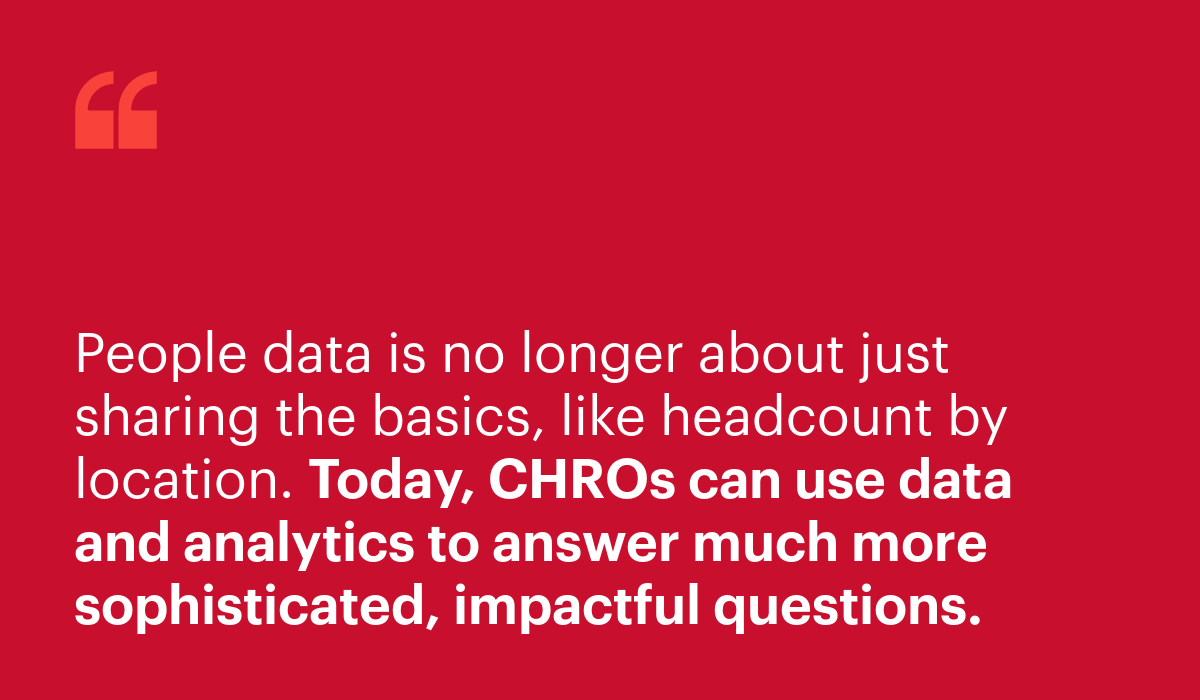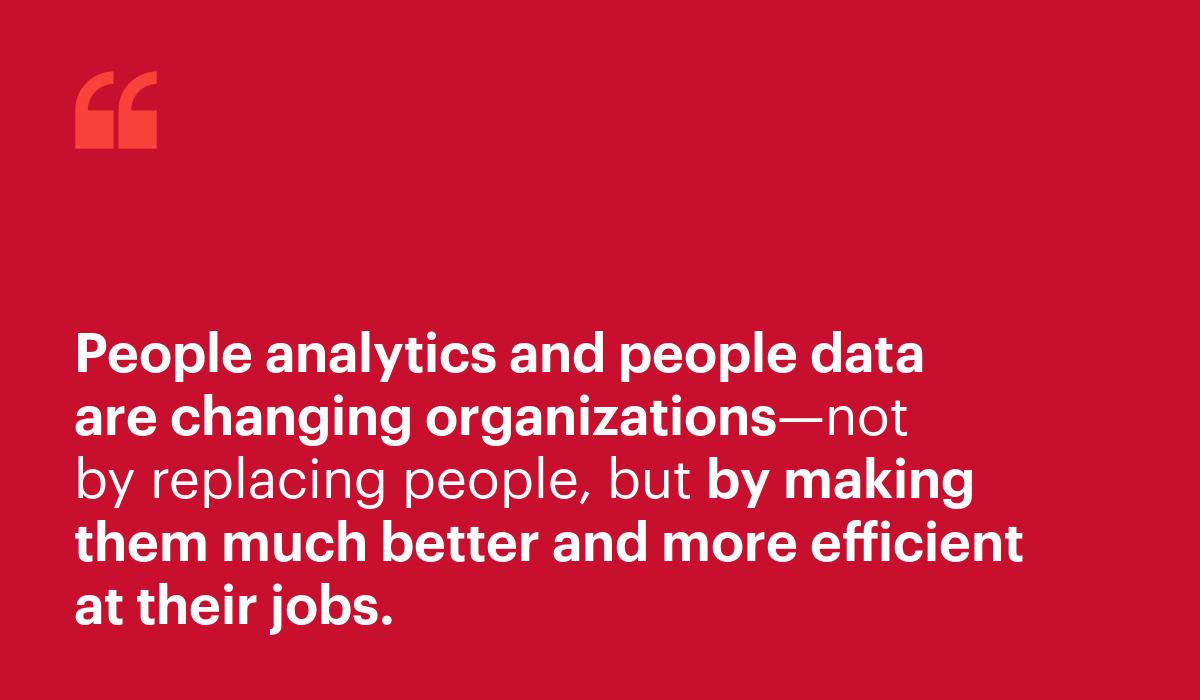Understanding People Challenges — And Building Products To Solve Them
To discuss how HR tech providers can build products that truly respond to their customers’ needs, we brought together three experts.

Creating a great HR tech product is about so much more than technical knowledge. First and foremost, it requires a deep understanding of users’ needs, challenges, and expectations. In HR, those needs are always changing, because the field focuses on something incredibly complex — people!
To discuss how HR tech providers can build products that truly respond to their customers’ needs, we brought together three experts. Here, we share insights from RedThread Research co-founder Stacia Garr, Paycor CPO Ryan Bergstrom, and Dave Weisbeck, Visier’s own CSO.
They discuss what it takes to create tech products with measurable impact outcomes and goals. Products that don’t just collect data and generate insights, but help CHROs, executives, and people analytics leaders apply them broadly across their organization.
Bringing people insights to the C-suite
To bring the power of people analytics to the C-suite, product teams need to understand the challenges CHROs—and the leaders they work with—are facing; the problems they’re expecting solutions to solve. How are these needs informed by trends and challenges facing the HR industry? Which of these are specific to the current moment, and which are long term goals that define a CHRO’s work? Once they understand their customers’ problems, HR tech product teams can better analyze how to tackle them in a specific, technical way.
What problems are CHROs facing?
Obviously, the HR world has faced pandemic-induced disruption over the last two years. COVID-19 permanently altered the culture of work, and created massive supply chain challenges with far-reaching impacts on many aspects of operations.
COVID-19 resulted in profound cultural changes in how people approach work, and what they expect from their employers—typified by the unprecedented wave of attrition known as the Great Resignation.
But the fundamental question CHROs are trying to solve is fairly simple, and remains unchanged:
How can CHROs make decisions about people that positively impact business performance? How do they outperform peers and competitors through the people decisions they make?
“What’s really happened with the pandemic is an acceleration in the digitization of work,” says Weisbeck. “The more distributed nature of talent, the greater need for collaboration—these trends did exist, but they were slowly being evolved into the workplace. Now, suddenly, we have to implement those in a business-critical way, instantaneously.”
CHROs are still trying to achieve the same goals. But now, it’s in an environment of massive change. Under these circumstances, business outcomes are more difficult to achieve, as companies navigate unforeseen complexities and variables.
“CHROs are under more pressure, and probably feeling more demand pulling at them now than ever before,” continues Bergstrom. “Not just from employees, but from the leaders right next to them. The C-suite is referencing big problems like the supply chain and resignations, and expecting their help in finding the right people strategy to deal with them.”
These pressures make the role of the CHRO more critical than ever. Today, HR leaders must be able to collaborate with their partners in the C-suite. They must respond to challenges intentionally and strategically, rather than reactively, to help their organization succeed.
Applying data to CHRO challenges
“We’ve always come from this belief that questions about people were difficult to answer with data, because people are squishy,” says Weisbeck. “They have feelings and emotions that can’t be captured in a headcount report.”
“But the reality is all the work that gets done in an organization gets done through people,” he continues. “If you want to improve an outcome, you should be thinking about staffing levels, staffing skills, training. You should be asking questions about people.”
In the past, businesses just didn’t have the volume, or quality, of data needed to answer complex questions about their people. But now, CHROs have richer data that absolutely can guide their strategy—if they put the technology, like Visier, in place to analyze and make sense of it.
People data is no longer about just sharing the basics, like headcount by location. Today, CHROs can use data and analytics to answer much more sophisticated, impactful questions. “We can do things like sense burnout,” Weisbeck explains. “We can know when it’s approaching, which can then be a very accurate predictor of resignation.”

Data has raised the standards of what HR leaders and the C-suite can accomplish, and enabled them to make decisions in a much more rigorous way. People analytics and people data are changing organizations—not by replacing people, but by making them much better and more efficient at their jobs.
“Gone are the days of managing by gut, and just being able to make the decisions based on feeling or intuition,” shares Bergstrom, and Weisbeck agrees. “To make the most of data, we need to build and organizational culture where we bring data and evidence, not belief and opinion. We need to foster that, and scale it across the business as a whole.”

Products that meet CHRO needs
For HR tech CPOs and product leaders, the challenge is not just meeting CHRO needs, but anticipating them.
“The real trick for CHROs is always to get ahead of the curve,” explains Weisbeck. “Not so far out that it’s not relevant, but I always kind of peg it at about six months. You want to be ready for what’s next, as much as possible in these current times.”
That sets the standard even higher for those developing HR tech and data products. “CHROs need to be looking six months out ahead, and we’re going to be building products to serve them,” agrees Bergstrom. “That means we need to be even further ahead than they are, so we can readily meet their needs. The biggest thing we can do, as tech providers, is understand their business. Not just CHRO-specific problems—industry-specific challenges.”
In practice, that means product leaders need to be spending as much time as they can with customers. While site visits are less practical amid COVID-related restrictions, CPOs and their people can still immerse themselves in customer interviews, focus groups, and brainstorming sessions.
“Why do customers even call you in the first place?” Bergstrom asks. “Really understand what’s driving change in their market. That’s going to help you create insights, identify the trends, look for things that will offer value in a solution for HR leaders.”
Weisbeck agrees on the importance of engaging closely with customers. “Talk to people, but observe them too,” he suggests. “You can learn a lot by observing, rather than talking. For example, from a user experience perspective, you can watch people using the solution, and see where they get lost and get confused.”
Friendly, accessible people analytics
Part of accommodating customer needs is understanding their background, and comfort level, with data. Many HR professionals do not come from the analytics space — they chose their field for it’s soft-skilled, human-centric nature. They might find people analytics intimidating, no matter how much they want to access its value.
According to Weisbeck and Bergstrom, people analytics can serve its users not just by providing them with answers, but by guiding them towards what to ask. “They’re already focused on questions,” says Weisbeck. “What if analytics was prompting great questions? What if instead of going into a blank-page experience, using people analytics felt natural, like a conversation with questions and answers?”
Modern people analytics solutions can also integrate more smoothly into users’ existing workflows. This makes them more valuable because customers no longer need to remember to stop what they’re doing and actively seek out data, nor do they need to take time away from regular work to do so.
“In the past, when you had to go look for analytics and look for information, it was kind of like stopping your car, and pulling over at a rest stop,” explain Bergstrom. “I think there’s an opportunity for technology to bring all this information right back into everyone’s flow from the HR leader down to a frontline worker. That makes data more accessible, and easier to act on.”
Results after launch
Product leaders must never stop engaging with customers, even after their solution is built and completed. In fact, it’s only once their product’s in use that tech providers can truly evaluate whether it’s delivering the value intended, and meeting users’ needs.
“The biggest thing tech providers should be thinking about is adoption,” says Bergstrom. “Is the product getting used? If so, great. Why? What did we do well and how can we build on that? If not, that happens too. Where should we pivot? What can we learn?”
After assessing whether the product is getting used, the next step is evaluating how much it impacts users’ desired outcomes and goals.
“Adoption is important, but I don’t think it should be the ultimate goal,” explains Weisbeck. “At the peak of the pyramid are business outcomes, and how the product is connecting to them. Product leaders need to be asking themselves, ‘Am I delivering value for this organization? And if so, how can I quantify that?’”
Overall, success with a people analytics product is about understanding what customer goals you are helping to realize, and closely evaluating the product’s ability to do so.
“In order to be successful, you should know up front what it is that you want to achieve,” finishes Weisbeck. “Understand what value you want to deliver for the organization, and then start to measure it, start to understand if you’re actually achieving it. This comes full circle, back to the whole point of using analytics.”
HR tech that solves problems
The needs of HR professionals are complex. But the path to great products that serve them is surprisingly simple.
As these experts share, it’s all about listening to, learning from, and engaging deeply with customers. Put their insights into practice with these key takeaways:
Understanding CHRO needs:
Despite current challenges, CHRO’s ultimate goal is always to make people decisions that improve business performance
CHROs must now harness data and analytics, not belief or intuition, to solve their problems
HR leaders are facing more pressure and responsibility from their C-suite peers than ever before
Creating products that meet HR needs:
Product leaders must get to know their customers’ businesses through plenty of interaction, in-person or virtual
Product leaders must make people analytics accessible, using strategies like question-and-answer interfaces and embedding analytics within customers’ existing workflows
Product leaders must evaluate success after launch, too. How widely has the product been adopted? Is it impacting critical business goals?

Interested in learning more? Recently, RedThread Research co-founder Stacia Garr hosted an exclusive Fireside Chat session with Paycor CPO Ryan Bergstrom and Dave Weisbeck, Visier’s own CSO. These experts shared actionable, in-depth tips how HR product leaders can understand their customers’ needs — and build products that serve them. Access the full recorded session here.
Get Outsmart content straight to your inbox
Subscribe to the People Insights Monthly newsletter for actionable insights and stories.
Subscribe now